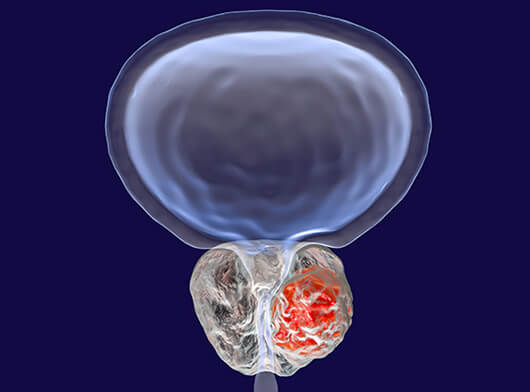- Surgery
- Radiation
- Medical Oncology
- Surgery to remove the prostate: Surgery for prostate cancer involves removing the prostate gland (radical prostatectomy), some surrounding tissue and a few lymph nodes. Radical prostatectomy can be performed in several ways:
- Robotic Surgery: Robotic prostatectomy allows the surgeon to make more-precise movements with surgical tools than is possible with traditional minimally invasive surgery.
- Open Surgery: Making an incision in the lower abdomen to remove the Prostate gland.
- Laparoscopic Surgery: This is a minimally invasive surgical procedure used to remove a patient's cancerous prostate. Laparoscopic surgery differs from traditional open surgery by making small incisions as opposed to large ones to perform the surgery.
- Orchiectomy: It is a Surgery to remove the testicles. Removing the testicles reduces testosterone levels in the body. It is a form of hormone therapy that is used in advanced prostate cancers to shrink the cancer cells and reduce the rate of growth of tumours.
- Radiation therapy uses high-powered energy to kill cancer cells. Prostate cancer radiation therapy can be delivered in two ways:
- External Beam Radiation Therapy (EBRT) - During external beam radiation therapy, you lie on a table while a machine moves around your body, directing high-powered energy beams, such as X-rays or protons, to your prostate cancer with various techniques such as IMRT, IGRT, V- MAT, Tomotherapy and particulate therapy like Proton Beam Therapy.
- In localised early-stage tumours, SBRT (Stereotactic body radiotherapy) using robotic radiosurgical machines like CyberKnife or Linear Accelerator is used. This procedure relies on real-time tracking of the tumour continuously during the radiation, is very precise and helps to preserve the adjacent healthy tissue like the rectum and bladder. The entire treatment is completed in 5 days compared to 6-8 weeks in conventional radiotherapy.
- Implant Brachytherapy The technique where radiation is given by placing radioactive seeds in the prostate tissue inside the body is called Implant Brachytherapy.
- LDR Brachytherapy The radioactive seeds (I-125 or Pd-103 deliver a high localised dose of radiation over a long period. The doctor implants the radioactive seeds in the prostate using a needle guided by ultrasound images. The implanted seeds eventually stop emitting radiation and don't need to be removed. This type of implant is also called a permanent implant, as seeds remain in the prostate gland forever. The seed becomes inactive after delivering the required dose of radiotherapy.
- HDR Brachytherapy: In this technique, the radiation is given by placing needles in the prostate, and a source of radiation (Ir-192) is then passed through these needles. This is called HDR Brachytherapy. It is also called a temporary implant as the needles and seeds do not remain in the patient after the procedure. The entire procedure is completed in a day, and the patient can go home in 3 days.
- Hormone Therapy
- Hormone therapy is a type of treatment to stop the body from producing the male hormone testosterone. Prostate cancer cells rely on testosterone to help them grow. Cutting off the supply of testosterone may cause cancer cells to die or to grow more slowly.
- Hormone therapy options include:
- Medical Management: Various injectable forms
- Surgical Management Orchiectomy
- Chemotherapy
- Chemotherapy uses drugs to kill rapidly growing cells, including cancer cells. Chemotherapy may be a treatment option for men with prostate cancer that has spread to remote body locations.
- Targeted therapy
- Targeting BRCA gene alteration is an option for those with BRCA or related gene mutations. This is based on the results of the genetic analysis.
- Immunotherapy
- Immunotherapy is a drug treatment that uses the immune system to fight cancer. The body's disease-fighting immune system may not attack cancer because the cancer cells produce proteins that blind the immune system cells from recognizing the cancer cells. Immunotherapy works by interfering with that process. Immunotherapy is an option for those with advanced diseases. The doctor might check the tumour tissue for specific biomarkers to understand the benefit the individual might derive from immunotherapy.
-
Active Surveillance
- In the case of men with low-risk prostate cancer, treatment may not be necessary right away. In such cases, doctors may just recommend active surveillance, which includes regular follow-up blood tests, rectal exams and possibly a biopsy to monitor the progression of cancer.



.png)
